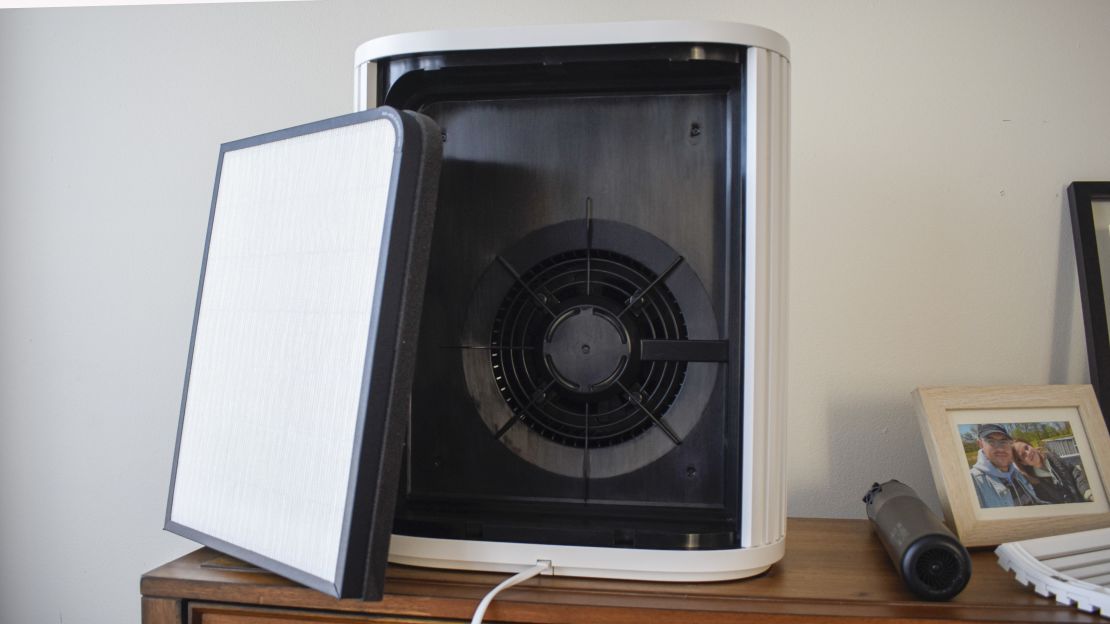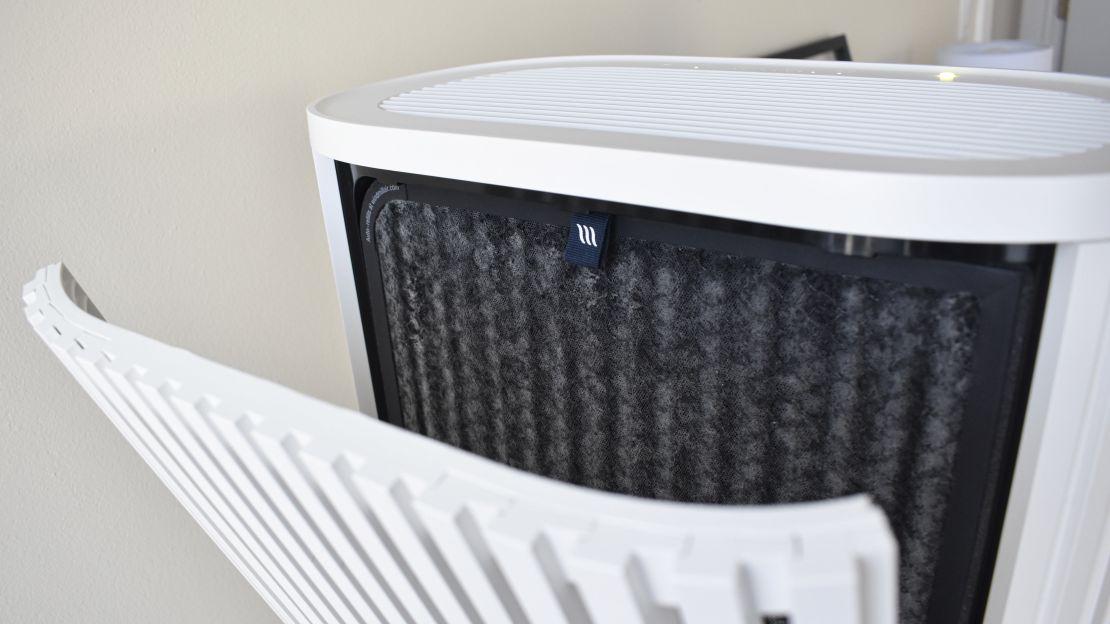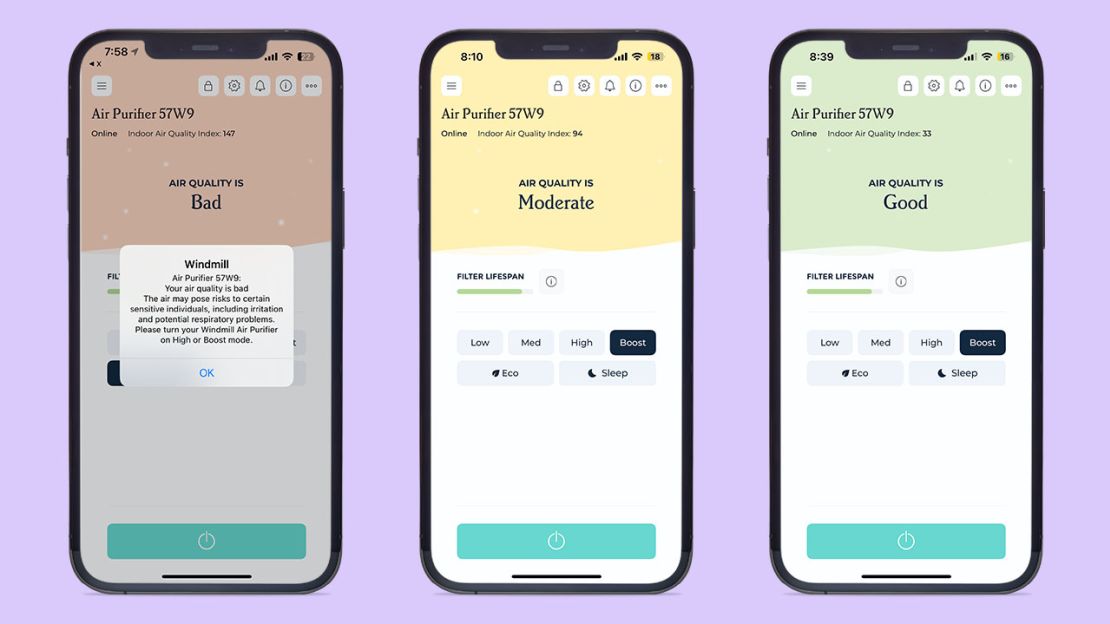I deemed the Windmill Air Purifier a product worth testing because it has a quality many of the best air purifiers lack — it actually looks OK. It’s not an eyesore I want stuffed into the back of a closet but rather an appliance that can fit in with just about any decor aesthetic. It’s the same reason we’ve long been fans of the Windmill AC, a window air conditioner that looks cool while cooling.
But after having the just-released Windmill Air Purifier up and running in my home for more than a month, its performance — and not its appearance — is why I can recommend it. Let’s dive into why.
The Windmill Air Purifier was made for those who care about what they’re breathing and what their living space looks like. Available in bamboo, white and navy, it carries all the expert certifications you’d want and is rated for spaces up to 400 square feet.
What I liked about it
It’s certified by people who know what they’re talking about
Knowing how to choose an air purifier involves various factors, so we like to start by trusting the guidance of a few different expert bodies. If a certain model isn’t endorsed by the California Air Resources Board (CARB), which tests for electrical safety and ozone emissions, and the Association of Home Appliance Manufacturers (AHAM), an organization that verifies performance claims, then you’re probably better off directing your search elsewhere. The Windmill Air Purifier has the backing of both CARB and AHAM. It’s also Energy Star-certified, so keeping it plugged in won’t blow up your electric bill.
AHAM tests air purifiers at an independent lab to verify if they actually clean the air as well as they’re claimed to. Clean Air Delivery Rate (CADR) is the metric to look for here. CADR measures the volume of clean air an air purifier produces, and knowing a device’s CADR can help you weed through manufacturer’s claims that tend to stretch the truth. CADR is typically measured in cubic feet per minute (CFM) and varies depending on the particles being removed from the air. The Windmill Air Purifier has a pollen CADR of 309, a smoke CADR of 260 and a dust CADR of 256.

So what does this all mean? Because we can trust the AHAM-verified CADR ratings, we can accurately determine how many air changes per hour (ACH) the Windmill Air Purifier can pull off in a given space. I’ve had my unit set up in my bedroom which is about 15 feet by 13 feet with eight-foot ceilings. So, by multiplying the Windmill Air Purifier’s lowest CADR (256) by 60 (because CADR is measured in minutes and we’re calculating hours) and dividing that number (15,360) by my room’s volume (1,560), we get more than 9 ACH. That means all of the air in the room is cleaned nine times an hour when the air purifier is set to high, which is helpful considering most particles you want to filter out — smoke from wildfires or germs from someone who’s sick, for example — are often entering the air in a continuous stream.
The experts we’ve consulted recommended between 4 and 6 ACH. The Windmill Air Purifier could still reach that threshold in a bigger room, say, one that’s 400 square feet. If you check the fine print on Windmill’s site, that’s actually the rated room size. Anything larger — like the more in-your-face claim of being suitable for rooms up to 1,950 square feet — won’t achieve enough air changes per hour to meet our experts’ suggestion.
Filtration without the gimmicks

Air purifiers work in ways we can’t see, and manufacturers tend to throw in features that sound as if they’re going to help — things like ozone generators, ultraviolet light and ionizers. The truth is, we don’t have enough proof these technologies make a positive impact on the air in your home. Some machines, like the Coway Airmega AP-1512HH Mighty, let you turn those features off. The Windmill Air Purifier forgoes them entirely — and I love that for it.
The 3-in-1 air filter included with the Windmill Air Purifier uses a few components you should understand, though. The outer layer contains a pre-filter to catch dust and pet hair, which you should gently vacuum off once a month. The middle layer of activated carbon traps odors and smoke. And finally, the inner True HEPA filter captures 99.97% of particles .3 microns or larger — in other words, nearly all the nasty stuff like bacteria and pollen found in the air you breathe.
HEPA filters are widely accessible and the standard nowadays, but having this 3-in-1 setup makes your life pretty easy. Windmill’s filter refill plan will run you $60 for a replacement that should last six months. At least for now, choosing that option when you add to cart knocks $50 off the price of the actual machine.
Approachable controls

There’s not much to think about when controlling the Windmill Air Purifier, and that’s a good thing. Clickable, physical buttons let you toggle between four fan speeds and an “eco” mode which will adjust based on a room’s air quality (there’s an on-board sensor for that). This was my go-to choice during testing, though I had some gripes. More on that later.
If you’re out of the house or on the other side of the room, the straightforward Windmill app makes changing settings easy. It also lets you set up schedules, like engaging the sleep mode when hitting the hay each night.
It’s not ugly

A calling card we’ve already covered, yes, the Windmill Air Purifier is easy on the eyes. The brand says its design was inspired by Japanese and Scandinavian architecture. I tested the white model but it also comes in a versatile bamboo or a stealthy navy. At roughly 21 x 20 x 12 inches, it fits great on top of my long dresser and accented the surrounding darker wood nicely.
I live in a fairly small apartment and test a lot of products, so I have more piles of stuff than I’d prefer. It’s especially bothersome to my fiancée, who wouldn’t mind less things stacking up in our home. So, the true test of how something fits into our living space is how tolerable she is of it — and the Windmill aced that one. It has withstood weeks in our bedroom without her asking when it will be shipped back or tucked away in storage. She might actually like it.
What I didn’t like about it
It’s quiet — until you turn it up
An air purifier is useless if it’s so loud you never want to turn it on. The Windmill Air Purifier doesn’t have that problem — when it’s at lower speeds. The low setting is undetectably quiet, and one step up doesn’t bother me. But the high setting is pretty loud at 54 decibels, and “boost” puts out untenable noise at 63 decibels. Windmill says the top setting is for “ultra-powerful cleaning when you’re out of the room.”
Even so, it’s important to remember the CADR ratings are based on the High setting, or setting 3. If you want to keep it set to a setting that doesn’t bother your ears, know that you’re sacrificing cleaning power. This is the case with any air purifier that has multiple speeds.
Eco mode isn’t instantaneous

I often kept my Windmill Air Purifier on Eco mode, and it rarely had to leave the lowest setting. At times, though, I wished it had made a quicker decision to accelerate on its own. I was testing a pizza oven in my kitchen one night, which isn’t far from where I kept the air purifier in my bedroom. It got a bit smoky while I cooked, and while the Windmill app alerted me that the air quality in my home had decreased, it didn’t automatically adjust. I had to select Boost mode on my own.
The positive takeaway is that the air quality sensor worked, and the light on top of the Windmill Air Purifier and the background color in the app went from red to yellow to green as the quality gradually returned to healthy levels.
How it compares
The best air purifier we’ve tested is the Coway Airmega AP-1512HH Mighty Air Purifier, which is more affordable to buy (and often on sale), a little cheaper to maintain and rated for rooms a bit smaller than the Windmill Air Purifier. I’d argue the Windmill Air Purifier looks better — that’s the point, right? — though the Coway Airmega Mighty isn’t abhorrent. Here’s how their specs stack up:
| Rated for rooms up to | 400 sq. ft. |
361 sq. ft. |
|---|---|---|
| Smoke CADR | 260 CFM |
234 CFM |
| Dust CADR | 256 CFM |
248 CFM |
| Pollen CADR | 309 CFM |
232 CFM |
| Noise level | 16-63 dB |
24-53 dB |
| 1 year of replacement filters | ||
| Size | 21.4 x 19.7 x 12 in. |
16 x 18.3 x 9.6 in. |
| Price | From $249 | From $161 |
Bottom Line
The Windmill Air Purifier checks just about every box you’d want it to. It actually cleans the air and has expert certification to back it up. It avoids unproven gimmicks that confuse consumers. A simple interface — via physical buttons or its companion smartphone app — takes the guesswork out of controlling it. It might not be the cheapest, but for an air purifier that can handle rooms up to 400 square feet, it’s not outrageously priced. And because it looks great in just about any setting, I’ll keep mine up and running in my home for the long haul.
Joe Bloss is an associate writer for CNN Underscored who tests and reviews products across a variety of categories, including kitchen appliances and smart home tech. He also really likes birds.




















